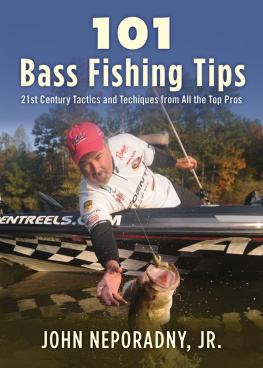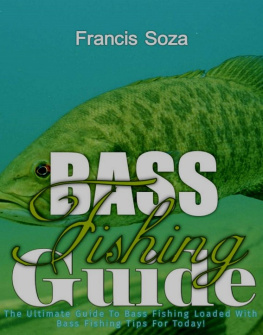JOHN NEPORADNY, JR.
Copyright 2013 by John Neporadny, Jr.
All photos 2013 by John Neporadny, Jr. unless otherwise stated
All Rights Reserved. No part of this book may be reproduced in any manner without the express written consent of the publisher, except in the case of brief excerpts in critical reviews or articles. All inquiries should be addressed to Skyhorse Publishing, 307 West 36th Street, 11th Floor, New York, NY 10018.
Skyhorse Publishing books may be purchased in bulk at special discounts for sales promotion, corporate gifts, fund-raising, or educational purposes. Special editions can also be created to specifications.
For details, contact the Special Sales Department, Skyhorse Publishing, 307 West 36th Street, 11th Floor, New York, NY 10018 or
info@skyhorsepublishing.com.
GSkyhorse Publishing, Inc., a Delaware corporation.
Library of Congress Cataloging-in-Publication Data is available on file.
Introduction
W hen insurance salesman Ray Scott held the First All-American Invitational Bass Tournament June 68, 1967, on Beaver Lake in Arkansas, he changed the world of bass fishing.
Before those 106 anglers gathered at Beaver Lake to fish the first ever cash-prize tournament, bass fishing was a leisurely weekend pursuit enjoyed by a smattering of anglers mostly from the South. In the last four decades, the increasing popularity of bass tournaments has turned the sport into a multibillion dollar industry enjoyed by millions of anglers throughout the United States and in a handful of foreign countries around the world.
During the early days of Scotts Bass Anglers Sportsman Society (BASS), only a small group of guides and serious competitive anglers fished professionally. Today most of the contestants on the Bassmaster Elite Series and FLW Tour circuits are full-time professionals who help educate the bass fishing public through seminars, videos, podcasts, and magazine and newspaper articles.
The influence of competitive bass fishing on the angling industry is comparable to NASCARs impact on the automobile industry. The same technology used to create lighter, faster race cars is being copied by the auto industry to improve fuel efficiency and increase safety features in the vehicles we drive every day. The pros on the tournament circuits have also proven to be invaluable test pilots for tackle manufacturers and boat builders, as these competitive anglers spend countless hours fishing in the sun, rain, wind, cold, or heat, navigating in high waves or making long runs at full speed to reach remote hotspots. Their exploits in all sorts of weather and water conditions have helped fishing companies create more durable, dependable tackle and boat manufacturers build safer and stronger bass boats.
Every major fishing tackle company and bass boat manufacturer have filled their pro staff teams with the best anglers from the national circuits, because these companies know the time the touring pros spend on the water gives them the expertise required to help a company research and develop products. So these companies rely heavily on the pro staffs for advice on creating new lures, rods, reels, and boats. Even the creation of the simplest gear, such as a pair of fishing pliers, has been influenced by the on-the-water trials of the bass pros.
Since they must make their living casting for cash, the bass pros also are adept at finding the right lure and targeting the best structure and cover to consistently catch enough bass to finish in the money. Weekend anglers might spend some time working the same cover or structure with their confidence lures and a few new ones they think will work. They might catch a few fish, but they usually miss out on the mother lode sitting on that spot.
On the other hand, the tournament pros know how to quickly sort through their myriad of lure boxes and pick the one or two best options that will boat a quick limit. By analyzing the season, weather, water clarity, and available forage, the pros can pinpoint the best presentation for every type of cover and structure without wasting time mulling through their vast array of tackle.
Their expertise and influence on the sport make the touring bass pros the logical choices as my sources for this book. The tips they share in the ensuing chapters should help you find largemouth bass quicker and trigger more strikes whether you are a competitive or recreational angler.
CHAPTER 1
Rods, Reels, and Line

1
Picking a Baitcast Reel
B ass anglers wanting to master various tactics of the pros must make the baitcast reel one of their key tools of the trade. Since reel manufacturers have made baitcasters highly specialized, the choices become more difficult when buying a new reel.
You want to buy the best quality reel you can afford because it pays off for you in longevity, says bass fishing superstar Kevin VanDam. Its going to cast better and perform better for you the whole life of the reel.
Gear ratio is a key consideration when buying a new baitcast reel. VanDam recommends buying a reel with a lower gear ratio, such as 5.3:1, for fishing with crankbaits and a medium gear ratio model (6.2:1 to 6.6:1) for spinnerbaits. A high-speed reel (7.3:1) is VanDams choice for burning spinnerbaits and square-bill crankbaits. The high-speed reel also allows VanDam to pick up slack line quickly when he is lifting and dropping plastic worms and jigs or popping a topwater lure.
Baitcast buyers should also consider the reels spool size. VanDam suggests small spool reels are easier to control while casting and backlash less than larger spools. The Michigan pro prefers small spools for skipping lures under docks and for light-line tactics. However, he opts for larger spools whenever he needs more line capacity for casting large crankbaits long distances or for heavier test lines and braid.

Kevin VanDam recommends using a premium baitcast reel because it will perform better and last longer than cheaper models.
Ball bearings play a key role in keeping the reel tight at all of its pivot points, so the buyer should pay close attention to the quality and quantity of the bearings. Most of the premium reels have ten ball bearings, says VanDam. A four ball-bearing reel might feel good at the store, but after a year of use it will probably be done. Those premium reels will feel the same at the end of the season as they did at the beginning.
2
Spinning Reel Options
B aitcast reels execute most bass fishing tactics well, but when touring pros face heavy fishing pressure, they depend on spinning reels to perform finesse techniques on finicky bass.
BASS pro Tim Horton favors spinning reels for drop-shot rigs, shaky head jigs, and small jerk baits. For most of these tactics, Horton spools his spinning reel with 6- or 8-pound test fluorocarbon, which he notes is stronger than 8-pound monofilament and has more sensitivity. The Alabama angler also fills some of his spinning reels with 15-pound braid.













